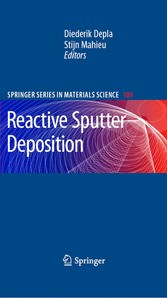Suchen und Finden
Preface
6
Contents
8
Contributors
15
1 Simulation of the Sputtering Process
19
1.1 Introduction
19
1.2 Computer Simulation Codes
20
1.3 Total Sputtering Yield
23
1.4 Differential Sputtering Yield
34
1.5 Sputtering from Rough Surface
46
1.6 Sputtering of Compound Targets
48
1.7 Conclusion
55
References
57
2 Electron Emission from Surfaces Induced by Slow Ions and Atoms
61
2.1 Introduction
61
2.2 Physical Mechanisms
62
2.3 Electron Yields
64
2.4 The Role of Ion-Induced Electron Emission in Glow Discharges
68
2.5 Outlook
76
References
76
3 Modeling of the Magnetron Discharge
79
3.1 Introduction
79
3.2 Overview of Di.erent Modeling Approaches for Magnetron Discharges
83
3.3 Challenges Related to Magnetron Modeling
92
3.4 Two-Dimensional Semi-Analytical Model for a DC Planar Magnetron Discharge
96
3.5 PIC-MCC Model for a DC Planar Magnetron Discharge
101
3.6 Extension of the PIC-MCC Model: To Include Sputtering and Gas Heating
133
3.7 Conclusions and Outlook for Future Work
141
References
142
4 Modelling of Reactive Sputtering Processes
149
4.1 Introduction
149
4.2 Basic Model for the Reactive Sputtering Process
151
4.3 Steady State Equations
154
4.4 Influence of Material Properties and Processing Conditions
159
4.5 Concluding Remarks
169
References
169
5 Depositing Aluminium Oxide: A Case Study of Reactive Magnetron Sputtering
171
5.1 Introduction
171
5.2 Some Experiments
172
5.3 An Extended Model for Reactive Magnetron Sputtering
185
5.4 Confrontation Between Experiment and Model
193
5.5 Towards a More Complete Model for Reactive Magnetron Sputtering
204
5.6 Conclusion
211
References
214
6 Transport of Sputtered Particles Through the Gas Phase
216
6.1 Introduction
216
6.2 Radial Distribution Where Sputtered Particles Leave the Target
217
6.3 Energy and Angular Distribution of Sputtered Particles Leaving the Target
218
6.4 Describing the Collision with the Gas Particle
225
6.5 Gas Rarefaction
234
6.6 Typical Results of a Binary Collision Monte Carlo Code
235
6.7 Specific Example: In-Plane Alignment of Biaxially Aligned Thin Films
240
6.8 Conclusions
241
References
242
7 Energy Deposition at the Substrate in a Magnetron Sputtering System
245
7.1 Introduction
245
7.2 Energy Measurement
247
7.3 Factors A.ecting Energy Flux
248
7.4 Total Energy per Deposited Atom
253
7.5 Energy Model
255
7.6 Conclusions
267
References
267
8 Process Diagnostics
271
8.1 Introduction
271
8.2 Electrical Probes
272
8.3 Mass Spectrometry
286
8.4 Optical Emission Spectroscopy
302
8.5 Optical Imaging
308
8.6 Laser-Induced Fluorescence
309
8.7 Summary
312
References
312
9 Optical Plasma Diagnostics During Reactive Magnetron Sputtering
317
9.1 Introduction
317
9.2 Emission Spectroscopy of Magnetron Plasmas
318
9.3 Resonant Absorption Spectroscopy of Magnetron Plasmas
327
9.4 Laser Spectroscopy of Magnetron Plasmas
336
9.5 Optical Diagnostic of High-Power Impulse Magnetron Sputtering Discharges
343
9.6 Conclusion
348
References
349
10 Reactive Magnetron Sputtering of Indium Tin Oxide Thin Films: The Cross-Corner and Cross-Magnetron E.ect
352
10.1 Introduction
352
10.2 The CCE and CME as an Inhomogeneous Target Erosion
353
10.3 Evidence of the CCE and CME From In Situ Measurements
361
10.4 CCE, CME and Film Property Distribution: ITO as an Example
369
10.5 CCE, CME and the Role of the Atomic Oxygen in the Process Gas
375
References
380
11 Reactively Sputter-Deposited Solid Electrolytes and Their Applications
382
11.1 Introduction
382
11.2 Crystallographic Basis of the Solid Electrolyte
384
11.3 Application of Solid Electrolytes
392
11.4 Conclusion
417
References
419
12 Reactive Sputtered Wide-Bandgap p-Type Semiconducting Spinel AB2O4 and Delafossite ABO2 Thin Films for “Transparent Electronics”
427
12.1 Introduction
427
12.2 Spinel and Delafossite Material
428
12.3 p-Type Transparent Conducting Oxides Based on Spinel and Delafossite Structure
431
12.4 Transparent Junctions Based on Spinel and Delafossite Oxides
455
12.6 Reactive DC Sputter Deposition of Delafossite p-CuAlO2+x Thin Film
469
12.7 Conclusions and Future Directions
487
References
491
13 Oxide-Based Electrochromic Materials and Devices Prepared by Magnetron Sputtering
499
13.1 Introduction
499
13.2 Energy Efficiency of Chromogenic Building Skins
500
13.3 Electrochromic Device Design and Materials
501
13.4 Properties and Applications of Electrochromic Foil
504
13.5 Conclusion and Outlook
507
References
508
14 Atomic Assembly of Magnetoresistive Multilayers
510
14.1 Introduction
510
14.2 Atomistic Simulations
518
14.3 Growth of Metal Multilayers
530
14.4 Ion-Assisted Growth of Metal Multilayers
545
14.5 Dielectric Layer Deposition
558
14.6 Ion-Assisted Reactive Growth of Dielectric Layers
566
14.7 Conclusions
568
References
568
Index
573
Alle Preise verstehen sich inklusive der gesetzlichen MwSt.









